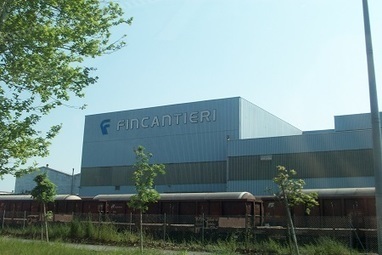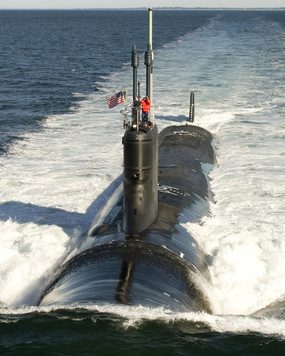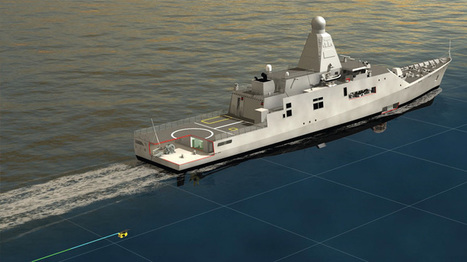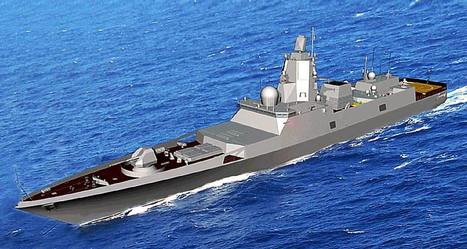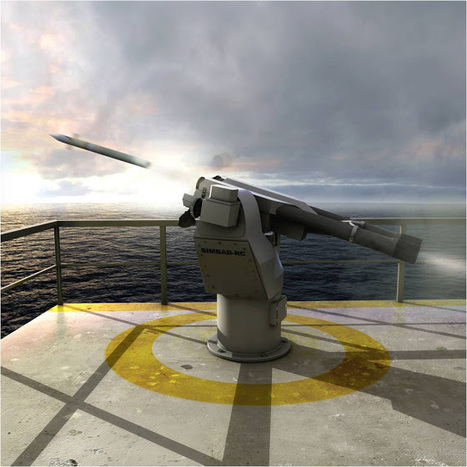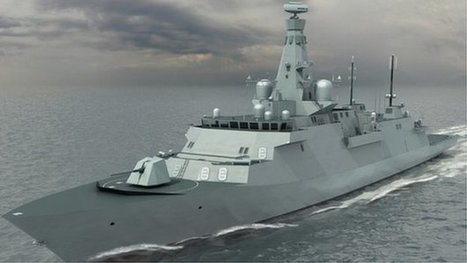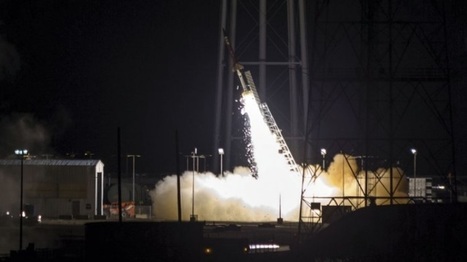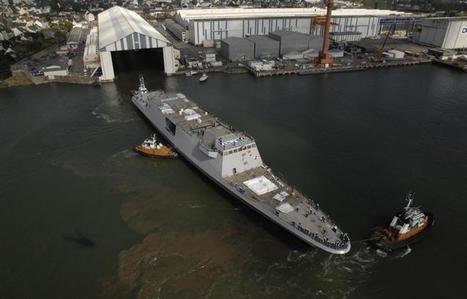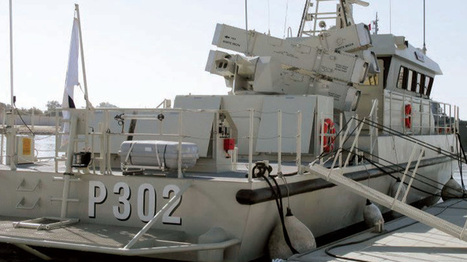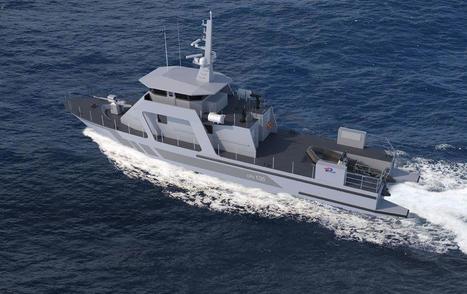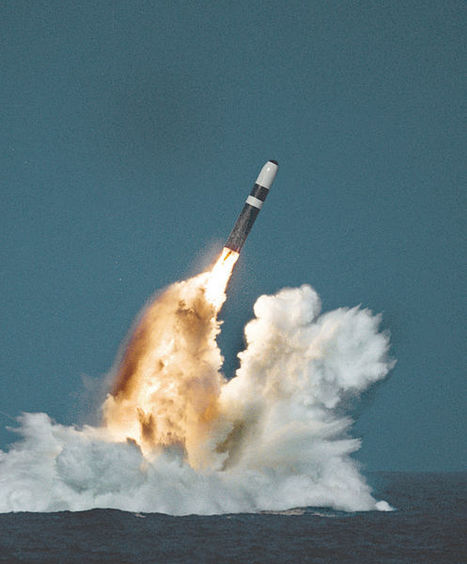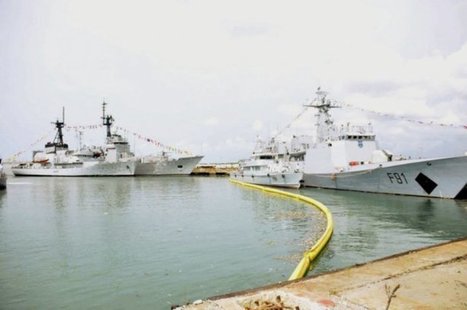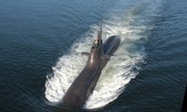TRIESTE (AGG) - Si è svolta oggi, presso lo stabilimento Fincantieri di Riva Trigoso (Sestri Levante, Genova), la cerimonia per il taglio della prima lamiera dell’ottava unità Fremm. Prosegue così il programma di costruzione delle Fregate Europee Multi Missione, la più importante iniziativa congiunta finora attivata tra industrie europee nel settore della Difesa navale. L’unità sarà lunga circa 144 metri, larga 19,7, e avrà un dislocamento a pieno carico di circa 6.500 tonnellate. Potrà raggiungere una velocità superiore ai 27 nodi e imbarcare un equipaggio di 145 membri, con una disponibilità di 200 posti letto. Si caratterizzerà per un’elevata flessibilità d’impiego e avrà la capacità di operare in molteplici scenari, particolarmente nell’ambito della sicurezza del bacino mediterraneo. Il programma Fremm, sottolinea una nota di Fincantieri, vede la partecipazione in qualità di prime contractor per l’Italia di Orizzonte Sistemi Navali. Attualmente il programma per l’Italia prevede la costruzione di dieci unità.
Get Started for FREE
Sign up with Facebook Sign up with X
I don't have a Facebook or a X account

 Your new post is loading... Your new post is loading...
At shipbuilding plant "Zvezdochka" repair work on the Carp B-239 submarine stopped. Perhaps, because of financing reduction. As told to the correspondent of FlotProm two sources at the enterprise and a source in the company contractor, all repair work on the head submarine of the Barracuda project 945 is curtailed now. The contract for repair and modernization of submarines of the Carp project 945 B-239 and B-276 "Kostroma" was signed with the Severodvinsk ship-repair center "Zvezdochka" on May 14, 2014. The center of ship repair "Asterisk" had to carry out troubleshooting of boats, unload nuclear fuel, replace all electric equipment, carry out repair of mechanical parts. During modernization of "Barracuda" had to receive new hydroacoustic stations, fighting management information systems, a radar, GLONASS/GPS navigation systems and systems of arms. It was planned that will return to structure of Navy of Russia "Carp" in 2017. The Carp B-239 submarine began the service in 1984 under the name K-239. I was a part of forces of constant readiness of Northern fleet. In 1990 it is declared by the best ship on fleet. In 1992 it is reclassified in ABPL and it is renamed into B-239. It is brought out of structure of fleet on May 30, 1998 and it is put on a trick in Severodvinsk. The second submarine of the Kostroma project 945 is put on April 21, 1984 at Red Sormovo plant in Gorky, floated on July 26, 1986, was a part of Northern fleet on December 30, 1987 under the name K-276. I had to pass modernization after a nuclear submarine "Carp". Submarines of projects 945 and 945A (B-336 "Pskov" and B-534 "Nizhny Novgorod") intended for fight against aircraft carriers and other submarines. Depth of immersion of boats makes 600 and 550 meters respectively. The ships of the project 945A are armed with six torpedo tubes of caliber 533 millimeters with a unit of fire of 36 torpedoes, and 945 - ─ two ─ caliber of 650 millimeters and four 533-millimetric (a unit of fire - 40 torpedoes).
Le groupe français Thales a indiqué le 26 février que son bénéfice opérationnel devrait augmenter de 15% en 2015, sous l'effet conjugué d'un retour aux profits de sa filiale DCNS et de ses économies. L'équipementier spécialisé dans l'aérospatiale, la défense et la sécurité précise également dans un communiqué anticiper pour cette année une légère progression de son chiffre d'affaires grâce à la hausse de près de 20% de ses prises de commandes en deux ans. Thales s'attend à ce que ses prises de commandes se maintiennent à un "niveau élevé" en 2015, avec une croissance dans les pays émergents.... ...Retour dans le vert pour DCNS Thales a réalisé un chiffre d'affaires de 12,974 milliards d'euros, en hausse de 2% en données publiées, mais en recul de 1% sur une base organique, au-dessus du consensus Thomson Reuters I/B/E/S. qui s'établissait à 12,872 milliards. Son bénéfice opérationnel de 985 millions d'euros, en ligne avec les attentes, donnant une marge en recul de 0,4 point à 7,6%. En excluant la contribution du constructeur naval militaire DCNS, consolidé à hauteur de 35%, la marge opérationnelle de Thales ressort toutefois en hausse de 0,9 point à 8,5%. DCNS a annoncé le 24 février qu'il comptait retrouver un bénéfice net en 2015 après une perte nette de 336 millions d'euros en 2014 entraînée par des provisions sur plusieurs contrats. Pour 2015, Thales table sur un bénéfice opérationnel de 1,130 milliard à 1,150 milliard d'euros, soit une hausse d'environ 15% au taux de change actuel. Le groupe confirme aussi viser pour 2017/2018 une marge opérationnelle comprise entre 9,5% et 10%, accompagnée d'une hausse "modérée" de son chiffre d'affaires. L'action a clôturé en baisse de 0,44% à 51,55 euros le 25 février, donnant une capitalisation de 10,66 milliards. Elle a regagné 14,6% depuis le début de l'année après avoir perdu 3,9% en 2014.
Washington – Navy officials have said they will consider moving up the date for the start of a new Virginia-class submarine program that would allow the boats to carry more firepower. About 20 Virginia-class submarines, built jointly by Electric Boat in Groton and Newport News Shipbuilding in Virginia, would have their hulls lengthened by about 70 feet to accommodate the so-called Virginia Payload Module, allowing the subs to carry 28 more Tomahawk cruise missiles than the Virginia class subs under construction now. Right now the Navy has planned construction of the first Virginia Payload Module for 2019. The new design is needed to provide more undersea strike capability as the Navy prepares to retire Ohio-class guided missile submarines in the mid-2020s. At a hearing of the House Armed Services seapower subcommittee on the Navy’s budget Wednesday, Connecticut U.S. Rep. Joe Courtney, D-2nd District, asked if the schedule for the Virginia Payload Module could be moved up. “I just wondered if you have any thought about possibly trying to accelerate that process?’” Courtney asked. Sean J. Stackely, assistant secretary of the Navy in charge of acquisitions, said the Defense Department is already trying to determine if the Virginia Payload Module subs could be built sooner. He asked lawmakers to “give us a couple of months to come up with” a decision. “The earlier we can do so, the better for our nation,” Stackley said. Stackely said the Navy must determine how quickly the module's design could be completed and whether Electric Boat and Newport News Shipbuilding could begin building the boats earlier than planned. Rep. Randy Forbes, R-Va., told Stackely, “We don’t have a couple of months" to wait for the Navy's decision because lawmakers are concerned about a "gap" in the Navy's firepower. "If you can narrow that scope down, it would be very, very helpful to us,” Forbes said. Stackely and other Navy officials also talked with lawmakers about the impact of across-the-the board spending cuts known as sequestration and other reductions in the Navy budget. Vice Admiral Joseph Mulloy said the Navy’s budget has been cut by $25 billion over the last three years. “We have the minimum necessary to be where it matters when it matters,” Mulloy said. “We are hanging on; we are making do.” The Navy’s 2016 budget contains money to build two Virginia-class submarines. But that budget — and the rest of the proposed federal budget sent to Congress by the Obama administration last month — does not take into account the impact sequestration cuts, which are still in effect. Most lawmakers, both Democrat and Republican, want to eliminate sequestration, across=the-board cuts established in the Budget Control Act of 2011 because lawmakers could not agree on a way to control spending. Partisan differences over spending priorities continue to foil all attempts to end sequestration.
Patrick H. 's insight:
En savoir plus sur le concept Virginia Payload Module (VPM) : http://news.usni.org/2013/11/04/navy-selects-virginia-payload-module-design-concept
Thales has revealed details of a new anti-submarine warfare (ASW) sonar pairing specifically designed for small ship applications. Engineered to allow installation on offshore patrol vessels (OPVs) down to about 800 tonnes, the new CAPTAS-1 low-frequency variable-depth sonar and BlueWatcher hull-mounted sonar are intended to provide littoral navies with a credible ASW deterrent capability. The CAPTAS family of low-frequency active/passive sonars was originally brought to market in the mid-1990s to meet growing demand for an improved surface ship ASW capability against quiet submarine threats. CAPTAS-1 builds on this pedigree, but shrinks the size to allow installation on small ships. CAPTAS-1 uses a single - dependent tow for the active sonar source (a single free-flooded ring transducer operating at a centre frequency of about 1.5kHz) and a triplet receive array. Thales has also developed a compact and lightweight towed array handling system that uses a single automatic winch. In July 2013, Thales (Stand B-030) conducted at-sea trials of a CAPTAS-1 engineering development model. According to figures released by the company, CAPTAS-1 will be able to operate at speeds of up to 12kts, and at depths down to 100m. Typical detection range is claimed to be in the region of 20-30km, depending on the target type and environmental conditions. To enable installation on smaller OPVs, Thales has reduced deck footprint to 15m2 and weight to about 8 tonnes. One option is to install CAPTAS-1 in containerised form, with the sonar body/receive array and electrically powered towed array handling system housed in a standard 20ft shipping container; the winch control and electronic cabinets are installed in a 10ft container mounted adjacent. Alongside CAPTAS-1, Thales is also introducing the BlueWatcher hull-mounted sonar, which repackages the transmitter and receive arrays from the FLASH airborne active dipping sonar to provide small ships with a compact, 360° multi-purpose sonar. Thales has engineered the BlueWatcher ‘wet end’ to fit in a cylindrical volume just 700mm in diameter and 600mm in height, limiting dome/draft requirements to 0.85m. Inboard components are limited to a single cabinet and the operator console. Only a single hull penetration is required out to the array. In active mode, used for ASW or collision/obstacle avoidance, BlueWatcher transmits on any one of three frequencies between 3-5kHz in FM (frequency modulation), CW (continuous wave) and combination pulse modes. In passive mode, the system can be used to detect small, fast surface craft. According to Thales, the implementation of adaptive beam-forming has delivered performance that is equivalent to an array twice the size. It also allows for installation on ‘noisy’ ships where there is no quietening or noise hygiene.
Traduction : Le portail des sous-marins http://www.corlobe.tk/spip.php?article37245 Un profond pessimisme s’est installé au sein de la marine espagnole à propos du projet de sous-marins S-80. Le programme ambitieux visait à doter la marine espagnole de sous-marins de dernière génération. Hélas, il a connu de nombreux revers, faisant apparaitre des doutes parmi les responsables à propos de son avenir. Au ce jour, certains estiment même que le programme devrait être repris depuis le début. Et, en attendant, de recourir à des sous-marins d’occasion. Incertitude. C’est le terme que les commandants de la marine espagnole utilisent pour définir la situation dans laquelle se retrouve le futur de la force sous-marine espagnole. Les sous-marins de la classe Agosta vivent leurs dernières années, et les retards qu’a connu le programme S-80 menacent de laisser l’Espagne sans sous-marins. Les responsables de la marine espagnole ont exprimé leurs craintes pour l’avenir, à l’horizon de la fin de la décennie, au cours de plusieurs réunions informelles qui se sont tenues au cours des derniers mois. Lors de ces réunions, ils ont mis sur la table les retards continuels que connait le programme, depuis les célèbres erreurs commises lors de la phase de définition, qui ont entrainé un sur-poids, obligeant à allonger de 7 m les sous-marins, jusqu’aux problèmes rencontrés avec le système de propulsion anaérobie. « Le projet est radicalement différent, de la façon dont il a été conçu à la celle dont il sera livré. Que ce soit au niveau des capacités techniques, des innovations ou du prix prévu, » assurent des sources militaires. Les problèmes du système de propulsion anaérobieLe système de propulsion anaérobie qui équipera les sous-marins S-80 « sera beaucoup moins ambitieux pour l’autonomie qu’il apporte que ce qui était prévu au départ. Il devait permettre au sous-marin de rester en plongée jusqu’à 20 jours. Aujourd’hui, selon les ingénieurs qui travaillent dessus, il est pratiquement impossible d’atteindre ce chiffre, » assurent des sources militaires. « Un sous-marin plus gros, avec moins d’autonomie et coutant entre 750 millions et 1 milliard € pièce, » concluent-ils. Un projet qui « coutera très cher à l’Espagne et qui repoussera tout pays qui aurait pu être intéressé. » C’est pourquoi, parmi l’état-major de la marine espagnole, de plus en plus d’officiers soutiennent une autre option : suspendre la construction des sous-marins et reprendre à zéro la conception en évitant de nouveaux dépassements de budget et sans précipitation. Le problème, c’est le temps : d’ici la fin de la décennie, l’Espagne n’aura plus de sous-marins opérationnels. Sans sous-marin jusqu’à la mise en service du S-82Les sous-marins de la classe Agosta qui sont encore opérationnels — Mistral, Galerna et Tramontana — ont subi des grands carénages au cours des dernières années afin de prolonger leur espérance de vie opérationnelle de 5 ans. Le Tramontona a été le dernier, et la marine espère qu’il lui sera rendu cette année. Cependant, la marine a des doutes raisonnables sur ces prévisions. Certains jugent « trop optimiste » que ces sous-marins puissent rester opérationnels encore 5 ans. « En 2016, nous n’aurons plus que 2 sous-marins après le désarmement du Galerna, le plus ancien. Et il nous faudra attendre jusqu’à 2020 avec le Tramontana et le Mistral, en tenant compte des entretiens et des réparations, et cela en supposant qu’ils puissent tenir 5 ans, » estiment les sources consultées au sein de la marine. Recourir à des sous-marins d’occasionSelon le calendrier de Navantia, le constructeur des S-80, le premier exemplaire sera livré en 2020. Concrètement, il s’agira du S-82, baptisé Narciso de Monturiol. Mais si les Agosta ne « survivent » pas jusqu’à cette date, l’Espagne n’aurait plus de sous-marins. Certains à l’état-major proposent donc que l’Espagne acquiert des sous-marins d’occasion, que ce soit par un achat ou une location, auprès d’autres marines. « Certains pays se sont lancés dans la rénovation de leur flotte sous-marine, alors qu’ils connaissaient la prospérité. Maintenant qu’ils ne peuvent plus payer, ils cherchent une porte de sortie. Ce serait une bonne option pour ne pas attendre le S-80, l’eau jusqu’au cou, et pour ne pas courir plus de risques que surviennent d nouvelles erreurs, » assurent-ils. L’Australie ne veut déjà plus du S-80Le dernier revers, survenu il y a seulement quelques jours, est le refus de l’Australie de retenir le S-80 dans la liste des candidats pour son projet de rénovation. Alors que le projet espagnol avait été inclus jusqu’à présent dans la liste, finalement, seuls les projets japonais, français et allemand ont été retenus. Rester à la porte de l’appel d’offres lancé par le pays qui avait montré le plus d’intérêt pour le S-80 constitue un « important échec commercial » pour les chantiers navals espagnols, et par conséquent, pour la marine espagnole comme le reconnaissent les sources militaires. Jusqu’à présent, il y avait l’espoir des éventuelles exportations sous-marins, de façon à ce que le cout total du projet et des recherches et développements nécessaires au développement d’un projet de cette ampleur ne repose pas uniquement sur l’Espagne, jusqu’à présent, le seul client, et probablement qui le restera.
Russia's Navy is seeking to use nuclear power to fuel its new destroyer-class vessels, Navy Chief Admiral Viktor Chirkov was quoted by Interfax as saying at a press conference in St. Petersburg on Friday. While the new warships are still in the design process, "the main priority is to [create] a nuclear-powered destroyer," the admiral said. Nuclear-powered destroyers remain a novel concept in naval technology. Nuclear reactors are typically reserved for vessels that remain at sea for extended periods of time, such as aircraft carriers and submarines. Although destroyer-class vessels are not precluded from similar long-term deployments, they are usually powered by conventional petroleum fuels, which require them to stop at overseas naval bases to refuel. But as Russia does not have any major naval refueling facilities beyond its shores, nuclear power is an attractive option for Moscow, which is keen to increase its global reach. Russia's navy, once an oceangoing powerhouse, has been largely relegated to coastal defense and short-range patrols by years of post-Soviet neglect and decay. Under President Vladimir Putin's ambitious rearmament program, though, the navy is looking to reverse its fortune with the construction of a brand-new fleet. Several submarines have already been built, and by 2050 Russia hopes to construct a completely new oceangoing surface fleet of destroyers, cruisers and perhaps even an aircraft carrier.
Patrick H. 's insight:
Pour mémoire, la Russie a commencé le développement d'une nouvelle classe de destroyers connue sous le nom de classe Lider (ou Leader) : http://www.globalsecurity.org/military/world/russia/ddg-newcon.htm
French shipyard CMN, part of Privinvest holding company, will unveil a new version of its famous Baynunah class corvette during IDEX/NAVDEX 2015 defense exhibition which starts on Sunday in Abu Dhabi. Based on the sea proven Combattante BR 71 corvette, the new Mk II evolution incorporates the latest innovations from CMN's research and development. It also leverages some of the design work from the FS56 Fast Attack Craft series. According to CMN, the vessel is designed for littoral warfare defence operations against air and surface threats, patrolling tasks, law enforcement and ISR missions.
European missile house MBDA has started qualification of its remotely controlled SIMBAD-RC ship self-defence system, and will begin production deliveries later this year. Developed from the manually controlled SIMBAD (Système Integré de Mistral Bitube d’Auto-Défense) twin-launcher system already in service with the French Navy and more than 10 export customers, the new SIMBAD-RC variant is a private venture development intended to address market requirements for a lightweight, automated close-in defence capability against air and surface threats out to a maximum of 6.5km. MBDA is partnered by Rheinmetall’s Defence Electronics business in Bremen, which is responsible for the design and development of the SIMBAD-RC turret. Configured with two ‘lock-on before launch’ Mistral infrared homing missiles, the basic SIMBAD-RC configuration comprises one or two lightweight, gyro-stabilised turrets equipped with a Sagem MATIS SP mid-waveband thermal camera and an optional wide field-of-view day camera. In addition, the system includes a dedicated compact terminal, known as SMU-RC, which can manage up to two turrets (interfacing with the ship’s combat system or surveillance sensors). Whereas the legacy SIMBAD requires an operator to man the above-decks weapon mounting, SIMBAD-RC is controlled remotely from a compact below-deck SMU-RC firing terminal. A single operator can control two SIMBAD-RC launcher systems from this station. In addition, SIMBAD-RC can be slaved to the ship’s radar or electrical-optical system for early cueing. Preliminary design activities for SIMBAD-RC were completed at the end of 2011. MBDA commenced the full-scale development phase at the beginning of 2012, with Rheinmetall being brought under contract for development of the production series turret. The first prototype SIMBAD-RC turret was delivered by Rheinmetall in June 2014, and is now undergoing qualification. Deliveries of series production units are scheduled to follow from mid-2015. MBDA has to date signed two contracts for the SIMBAD-RC system: one order to equip patrol vessels (two turrets per vessel); and a second order for the self-defence of high-value support ships (four turrets per ship). While the company declines to identify either customer, it is understood that the two navies in question are Turkmenistan (to equip new P 1200 class patrol vessels) and Saudi Arabia (for retrofit to the Royal Saudi Naval Forces’ two Boraida class auxiliary replenishment ships).
On February 20, Shipyard Severnaya Verf OJSC (Saint-Petersburg) laid down corvettes of project 20380 for RF Navy, the shipyard told IAA PortNews. The company is dedicated to construction, repair and retrofitting of surface warships, including destroyers, frigates, corvettes under the state defense contracts for the Russian Navy. The company also executes contracts for foreign Navy under military and technical cooperation. Severnaya Verft also specializes in commercial shipbuilding for the domestic and foreign markets, manufacturing PSVs of various types, icebreakers, tankers and 12000 dwt dry cargo carriers.
The Ministry of Defence (MoD) has signed an £859m initial development deal for the next generation of Royal Navy warships to be built on the Clyde. The move will "support progression" towards the manufacturing phase of the new Type 26 Global Combat Ship. The UK government said the contract would safeguard 1,700 UK jobs, including 600 in Scotland, at both BAE Systems and its supply chain. The news came as Prime Minister David Cameron visited BAE Systems at Govan. The Type 26's manufacturing phase is expected to begin in Glasgow in 2016. The first frigate is due to enter service in the early 2020s, with the class of ship expected to remain in service until 2060. 'Substantial investment' The UK government said the deal would involve about 30 companies in the maritime supply chain and enable investment in essential long-lead items, including equipment such as gas turbines, diesel generators and steering gear for the first three ships. Mr Cameron said the contract represented a "substantial investment" in the shipbuilding industry. He added: "Investing in these warships will ensure we continue to keep our country safe, at home and abroad. "As part of our long-term economic plan, we're not just building the most advanced modern warships in the world - we are building the careers of many young people with apprenticeships that will set them up for life." 'Proud heritage' BAE Systems chief executive Ian King said: "We have a long and proud heritage of delivering complex warships in the UK and today's announcement is a significant endorsement of the government's commitment to sustain this important national capability. "Through the Type 26 programme, we are transforming the way we design and manufacture naval ships with innovative new technologies, leading-edge processes and modern infrastructure. "New ways of working ensure we can continue to deliver the highest quality equipment at the lowest possible cost and compete effectively for future UK and international orders." David Hulse, national officer of the GMB union, said: "This announcement is very good news in that it secures the future of the Clydeside shipyards and the skilled workforce and will enable the company to provide a substantial number of much-needed apprenticeships." Shadow defence secretary Vernon Coaker said: "Following this Tory-led government's substantial delay in approving this contract, it is now crucial that the programme runs on budget and on time."
The Republic of Ireland is to give an offshore patrol vessel to Malta to help it cope with the migration crisis. Defence Minister Simon Coveney agreed to give the recently decommissioned Le Aoife to Malta following a meeting in Latvia with Home Affairs and National Security Minister Carmelo Abela in the margins of the informal meeting of EU Defence Ministers. “The Maltese authorities require the ship for their armed forces to assist in the patrolling of the Mediterranean Sea to deal with the ongoing difficult refugee crisis in the region. Recent tragic events in that part of the Mediterranean have underlined the significant challenges which need to be addressed by the international community and Ireland is very keen to play an active part in this regard,” Mr Coveney was quoted as saying as The Irish Examiner. “I welcome this very important contribution from Ireland which will help in bridging a gap in Malta’s naval capacity pending our future acquisition of a new offshore patrol vessel,” Mr Abela said. Le Aoife, which is 65.2m long and has a displacement of 1019.5 tonnes, will be the biggest vessel to join the maritime squadron of the Armed Forces of Malta. It was built 35 years ago and used mostly on fishery protection duties but is also sailed in other parts of the world including the Mediterranean to supply Irish troops involved in UN missions. It was in Malta in 2007. The ship was the oldest in the Irish Navy and sailed in excess of 600,000 nautical miles. Its crew has boarded over 4,700 vessels at sea and detained over 440 fishing vessels. It was decommissioned last month. The ministers also discussed further cooperation including in the training of Maltese personnel in Ireland and future potential operations, building on the successful joint training team Malta and Ireland provided to the EU Training Mission in Somalia.
Traduit du grec par Google traduction : In "water" fell last week the new submarine our Fleet submarine "MATROZOS» (S-122) to start sea trials (SAT), while it was ready for today's ceremony of "launching" and " naming "exactly as was done for previous" PIPINOS "and" OCEAN ". Ceremony but canceled last week due to the very significant polar and diplomatic developments of days with critical Eurogroup and announcing the name of the President of the Republic, etc. The ceremony will take place shortly at the premises of Greek Shipyards SA (HSY) in Scaramanga, where it was built from the keel underwater, the second in the series made by Greek hands after 'PIPINOS "Class" Papanikolis »Type-214 AIP .
Patrick H. 's insight:
Le premier construit en Grèce avait été mis à l'eau en octobre 2014 : Le S-123 Katsonis devrait suivre rapidement... Retour sur cette saga du contrat Allemagne-Grèce qui remonte maintenant au début des années 2000 : |
The US Missile Defense Agency (MDA) on 24 February demonstrated the ability of Aegis destroyers to co-ordinate and determine the best ship to engage multiple short-range ballistic missile targets launched near simultaneously. The latest ballistic missile defence (BMD) test, which took place off the coast from Wallops Island, Virginia, demonstrated Lockheed Martin's Distributed Weighted Engagement Scheme (DWES). The capability enables automatic engagement co-ordination between ships to help avoid having to launch multiple missiles to shoot down the targets, Paul Klammer, director of BMD programmes, integration, and strategy for Lockheed Martin, told reporters on 24 February. "[We were] testing sophisticated algorithms that we put in place as [part of the] BMD 4 functionality to make sure these ships co-ordinated their engagements and to make sure that the ship that had the best shot at the target took it," he said. "We reduced duplication of BMD engagements. It also saves on missile expenditures; from an inventory perspective it is important that that functionality works. It also gave us a great opportunity to test that the system works in a raid scenario where you have three very challenging short-range separating BMD targets." For the test, USS Carney (DDG 64) and USS Gonzalez (DDG 66), both equipped with the Aegis Baseline 4 capability, acquired and tracked three short-range ballistic missile targets launched from NASA's Wallops Flight Facility, Klammer said. "In this scenario one ship took two shots and one ship took one. The USS Gonzalez took two [shots] based on how DWES [determined] who had best shot. The system can be configured to automatically fire or have operator intervention," he said. Both ships fired simulated Standard Missile-3s. Lockheed Martin, the MDA and US Navy (USN) have a lot of data to go through from the event. Klammer noted the DWES algorithm that determines the preferred shooter performed as designed. A third ship, USS Barry (DDG 52), equipped with Aegis baseline 9, also took part in the test, but it did not participate in the co-ordinated tracking and engagement of the three ballistic missile targets, he added. "[ Barry was] tracking the three targets and doing simulated engagements similar to what the other ships were doing, except that [ Carney and Gonzalez ] were testing out DWES," Klammer said. " Barry gave us an opportunity to use the latest Baseline 9 build and make sure we could do simultaneous engagements in the same raid-type scenario." The difference between Carney and Gonzalez equipped with Aegis Baseline 4 and Barry equipped with Baseline 9 is that the baseline 4 ships have a combination of the older UYK military-based and commercial off-the-shelf computers and rely on the ballistic signal processor functionality, Klammer noted. Barry just received Baseline 9, which has the latest software configuration that brings an integrated air and missile defence capability to the ship. Baseline 9 also has the multi-mission signal processor, which is capable of conducting both air and BMD missions simultaneously. Aegis Baseline 9 has DWES capability built in. Additionally two cruisers, USS Lake Erie (CG 70) and USS Shiloh (CG 67), have DWES functionality.
Alors qu'il doit prochainement recevoir une centaine de marins égyptiens afin d'assurer la prise en main de l'ex-Normandie dont la livraison à l'Égypte est espérée cet été, le site DCNS de Lorient s'attend à un pic de charge sur les parties coques dans les prochains mois. En effet, le lancement de l'usinage courant avril de la corvette Gowind destinée à l'Égypte va de pair avec le recadencement du programme Fremm qui prévoit, d'ici la fin de l'année 2015, la livraison de la Provence à la Marine nationale, l'achèvement des essais en mer de la Languedoc et la mise à l'eau de l'Auvergne. Piloté depuis décembre par Pierre Salmon, ancien directeur industriel de DCNS Indret, le site lorientais compte s'appuyer sur le renfort de salariés en provenance de Brest et de Cherbourg ainsi que de la sous-traitance par Piriou d'environ 20 % des éléments de coque de la corvette. L'amiral Rogel, chef d'état-major de la Marine, a fait savoir que sa priorité était de disposer de quatre frégates Fremm en 2016 et de six en 2018.
Abu Dhabi Ship Building (ADSB) has announced the completion of the Ghannatha Phase II programme after delivery of all 24 vessels to the UAE Navy. Built to a design developed by partner Swede Ship Marine (Stand C-015), the Ghannatha-class boats are high-speed, aluminiumbuilt multi-role combat vessels. Powered by two MTU diesels driving twin Rolls-Royce FF 600 waterjets, the design is capable of speeds up to 45kts. ADSB (Stand B-022) won the Ghannatha Phase II contract, valued at nearly AED1 billion, in 2009. Under the deal, the company has delivered 12 new 27m Ghannatha boats to the UAE Navy, and retrofitted modifications to 12 existing 25m craft. Six of the original vessels have been modified as mortar boats,receiving the Patria Nemo 120mm smooth-bore mortar system, plus an OTO Melara Hitrole-G 12.7mm gun mounting. These vessels have also received a GEM surveillance radar and updated VHF/UHF communications. The other six 25m Ghannatha boats have been modified to serve as fast gun boats, equipped with a Rheinmetall MLG 27 27mm gun and a Hitrole-G 12.7mm mounting. They also retain the capability to embark up to 40 troops. Swede Ship Marine, as ADSB’s principal sub-contractor, took responsibility for the design modification package for the 12 ‘stretched’ new-build vessels, and built the first three in Sweden. The nine follow-on craft have been built by ADSB at its shipyard in Abu Dhabi’s Mussafah industrial area. As well as being 2m longer than the original 25m Ghannatha design, these later ships have also received more powerful MTU 12V 2000 M93 engines. All 12 of the later ships are configured as missile boats, being equipped with four box launchers for MBDA Marte Mk 2/N surface-to- surface guided missiles. The Marte Mk 2/N missile is able to strike targets at ranges in excess of 30km, flying a fire-and-forget sea-skimming profile using mid-course inertial guidance and active radar homing. The vessels are also fitted with a mini-combat system supplied by Selex ES and a GEM radar for surveillance and target indication. Abu Dhabi Systems Integration (ADSI) has taken responsibility for combat system engineering and integration activities for the Ghannatha Phase II programme. ADSI, a joint venture between ADSB and Selex ES, has overseen combat system definition and design, production, support to installation, setting-to-work, integration, commissioning and acceptance.
Patrick H. 's insight:
Retour sur le déroulement de ce programme : Les 3 premiers de la série ont été construits en Suède par Swedeship Marine. Le 1er construit localement avait été lancé à ADSB en juillet 2012 :
Piriou va lancer la construction de ses deux premiers patrouilleurs côtiers. Il s’agit d’unités de 32.5 mètres de long et 6.4 mètres de large du type CPV 105, l’un des nouveaux designs dévoilés par le chantier breton fin 2014. La découpe de la première tôle de la tête de série interviendra à Concarneau vendredi, et sera symboliquement présidée par le ministre de la Défense, Jean-Yves Le Drian, à l’occasion de sa visite du site. Ces deux patrouilleurs ne sont, pour autant, pas destinés à la France, pas plus, assure-t-on de source industrielle, qu'à l'Arabie Saoudite. Piriou, qui ne dispose pas encore de produit éprouvé à la mer pour ce type de bâtiment, a en fait décidé de les réaliser sur fonds propres afin de disposer d'une première référence. Il s’agit donc de bateaux réalisés sans contrat, la société comptant les vendre au cours de leur construction ou une fois testés, sachant qu’ils seront opérationnels début 2016. Lire l'intégralité de l'article sur Mer et Marine : 
Concarneau Cornouaille Agglomération's curator insight,
March 4, 2015 2:56 AM
Piriou va lancer la construction de ses deux premiers patrouilleurs côtiers. Il s’agit d’unités de 32.5 mètres de long et 6.4 mètres de large du type CPV 105, l’un des nouveaux designs dévoilés par le chantier breton fin 2014.
The US Navy has successfully conducted the 155th test flight of two unarmed Lockheed Martin-built Trident II D5 Fleet ballistic missiles, which were launched in the Pacific Ocean from a submerged Ohio-class submarine. Lockheed Martin Space Systems Strategic and Missile Defense Systems deputy and Fleet Ballistic Missile programmes vice-president Mat Joyce said: "These latest test flights demonstrate the reliability of the D5 missile and the readiness of the entire Trident strategic weapon system, every minute of every day. "The navy programme office, the submarine crews and the industry team never rest to ensure the safety, security and performance of this crucial deterrence system." Prior to testing, the missiles were adapted to test configurations using kits comprising a range safety devices and flight telemetry instrumentation. The US Navy performs a series of operational system evaluation tests for the Trident strategic weapon system under the testing guidelines of the Joint Chiefs of Staff. Trident II D5 is a three-stage, solid-propellant, inertial-guided ballistic missile, capable of travelling a range of 4,000nm while carrying multiple, independently targeted re-entry vehicles. It is currently aboard the US Navy Ohio-class and UK Royal Navy Vanguard-class submarines. The missile's design was completed in 1989 and was first deployed in 1990. Lockheed Martin Space Systems is the strategic missile prime contractor for the US Navy's strategic systems programmes.
Istanbul, 24 Fév. 2015 (MAP)- Le président turc Recep Tayyip Erdogan a relancé le projet gigantesque du Canal d’Istanbul pour le désengorgement du Bosphore, une voie d’eau de 43 km entre la mer Noire et la mer de Marmara, lors d’une réunion avec des ministres concernés, rapporte la presse turque. Avec une largeur de 400m et une profondeur de 25 m, selon la nouvelle version du projet, le canal sera enjambé de six ponts et transformera la partie européenne d’Istanbul, seule ville au monde à cheval sur deux continents, en une île artificielle, indique, mardi, le +Daily Sabah+. Lancé une première fois avant la campagne des législatives 2011, ce projet grandiose ressurgit à nouveau avant le scrutin électoral législatif (7 juin). Il sera conçu pour assurer le passage quotidien de 160 navires de très gros tonnages dont les supertankers et sera parallèle au Bosphore à l’ouest d’Istanbul. Pour les autorités, le canal doit alléger le trafic sur le Bosphore et faire diminuer le risque d’accident dans le détroit large, en certains points, de seulement 700 m. Deux collisions s’étaient produites en 1979 et 1994 faisant respectivement 41 et 29 morts. Ce projet, devant être réalisé dans le cadre du partenariats public-privé, serait rentable avec la construction d’une nouvelle ville de 500 mille habitants le long des deux rives du canal au lieu de 1,2 million dans le projet initial de 2011 mais également grâce aux droits de péage contrairement aux statuts Bosphore et des Dardanelles, datant des accords de Montreux en 1936, prévoyant, en temps de paix, la libre circulation et sans aucun frais. En liaison avec ce canal, les plans pour l’édification du troisième aéroport de la mégalopole turque ont été modifiés puisqu’il était prévu qu’une partie des 152 millions m3 de terre extraits lors du percement pourrait être utilisée dans la construction de cet aéroport, sur une ancienne région minière, à proximité de l’embouchure du canal sur la Mer Noire. Cet aéroport, dont le coût global est estimé à 7 milliards de dollars, ambitionne d'être le plus grand aéroport au monde avec à terme 150 millions de passagers par an.(MAP).
Patrick H. 's insight:
Les russes avaient, en 2013, exprimé leurs craintes de voir, avec ce projet, l'équilibre militaro-politique régional déplacé en faveur de la Turquie et de ses alliés, dans la mesure où le canal artificiel risque de ne pas être soumis aux conditions de la convention de Montreux. On pourra lire l'analyse russe de cette affaire ici :
Key Points
Kazakhstan's Zenit Uralsk Shipyard is planning to launch a fifth Project 0300 Bars-class patrol vessel for the Kazakh coastguard service in April 2016. The yard also will start work on a fourth Project 250 Kazakhstan (or Bars-MO)-class missile patrol boat for the country's navy, following a recent order from the Kazakh Defence Ministry. The construction of this ship is expected to take two years. News of these developments was revealed on 16 February on the website of national defence company Kazakhstan Engineering, with the website citing local media reports. Based on the Russian Project 22180 fast supply vessel design, the Project 0300 ships in service with Kazakhstan's coastguard - known formally as the Maritime Border Guard Service of the National Security Committee of Kazakhstan - are 41.75 m long, 7.8 m in beam, and have a draft of 2.5 m. They displace around 218 tonnes. Two MTU 16V4000 M71 series engines driving through ZF 7550A gearboxes provide a top speed of around 30 kt. Range is 1,200 n miles and endurance is 10 days. The ships' complement is 23. Armament typically comprises a 2M-3M gun mount with twin 14.5 mm machine guns, as well as 12.7 mm heavy machine guns. The Project 250 patrol vessel for the Kazakh Navy is a further evolution of the Project 300 design with broadly similar hull specifications, although the 230-tonne full-load ships are slightly longer at 42.2 m and heavily armed in comparison to the coastguard ships. They are likely to be fitted with a Ukrainian combat system comprising the Kaskad-250 command-and-control system; an AK-306 gun controlled by a Sens-2-250 electro-optic device; the Arbalet-K system with four SA-N-10 Igla anti-aircraft missiles; a Baryer-VK launcher with four RK-2V anti-tank missiles; a Delta-250 2-D I-band air-/surface-search radar; and a Furuno navigational radar. Meanwhile, Zenit is executing a major refit and modernisation of a coastguard 14 m Project 100M Sunkar-class patrol craft that entered service 11 years ago. The patrol craft in question is understood to be pennant number 503.
At IDEX 2015 exhibition in Abu Dhabi, Italian company Oto Melara unveiled a new 40mm naval gun system weighting just below two tons. Thanks to its extremely reduced mass, small dimension, easy installation (no deck penetration required), modern and completely digital technology, Oto Melara believes the Forty Light will play a leading role as a 40mm naval system. The full integration between high rate of fire and modern programmable ammunition enables the system to engage efficiently and effectively a large number of targets. In particular, the high operative flexibility allows to cover the most differentiated roles, typical of modern naval scenarios: generic surface threats, fast crafts, antiships helicopters and fast attacking aircraft as well as various missile typologies. a local emergency control is required, in addition to the remote control mode it is possible to adopt the coaxial configuration that foresees a high performance daylight camera installed on the gun mount. This camera allows the system control in an emergency autonomous mode if the CMS is not available.
La flotte de sous-marins de la classe Victoria est maintenant opérationnelle, et trois des quatre sous‑marins sont disponibles pour des opérations, indique le plus récent état de la flotte de la Marine royale canadienne en date du 19 février. Les NCSM Windsor, Victoria et Chicoutimi étaient tous en mer en décembre 2014 et ont passé un total cumulatif d’environ 260 jours en mer en 2014. Le NCSM Corner Brook est actuellement à quai au chantier Victoria Shipyards afin de se soumettre à sa période en cale sèche prolongée dans le cadre du contrat de soutien en service de la classe Victoria conclu avec Babcock Canada Inc. Il devrait y rester jusqu’en 2017. Les sous-marins canadiens œuvrent généralement en un cycle opérationnel dans le cadre duquel chaque bâtiment est disponible auprès de la flotte pendant six ans, ce qu’on appelle la « période opérationnelle », suivie de deux ans de grands travaux de maintenance durant une période en cale sèche prolongée, indique la marine royale canadienne dans son état de la flotte. En raison de leur petite taille et de leur système de propulsion électrique extrêmement silencieux, les sous-marins diesel-électriques conventionnels comme ceux de la classe Victoria sont dotés de capacités furtives et d’une manœuvrabilité accrue comme on a pu le voir avec le sous-marin Victoria lors de l’exercice RIMPAC 2012. Ils possèdent des avantages dans certaines conditions par rapport aux sous-marins nucléaires, spécialement sur les côtes et dans des points d’étranglement stratégiques, ce qui fait d’eux un atout précieux pour le Canada et nos partenaires internationaux durant les années à venir... ...Outre représenter un atout stratégique pour le Canada, les sous-marins peuvent aussi jouer toute une gamme de rôles navals en temps de paix: surveillance des pêches, surveillance des trois côtes canadiennes, appui aux organismes maritimes d’application de la loi et aux autres ministères, dissuasion des terroristes, contrebandiers et pollueurs potentiels, etc.
In a landmark event in the Nigerian Navy's recapitalisation programme, President Goodluck Jonathan commissioned four naval vessels in Lagos on 19 February. The four warships were the NNS Centenary (F91), the first of two P18N off-shore patrol vessels (OPVs) ordered from China; NNS Okpabana (F92), Nigeria's second ex-US Coast Guard Hamilton-class cutter; NNS Sagbama (P184) and NNS Prosperity (A497). Sagbama is a 46 m Type 62 patrol boat (River Town class in Nigerian service) that is identical to the one delivered to the Seychelles in 2014. During the commissioning ceremony, Nigerian Navy chief Vice Admiral Usman Jibrin said it had been donated by the Chinese government in appreciation of the cordial relations between the two countries.
The Australian Submarine Corporation can take part in the tender process to build Australia’s new submarines, provided it works with an international partner. France, Germany and Japan will be invited to formally enter the contest to build Australia’s new submarines in a process which does not rule out construction in Adelaide. But culled from the shortlist is Sweden - which designed Australia’s Collins class submarines - because it has been almost two decades since the last Swedish sub rolled off a production line. Prime minister Tony Abbott said designing and building subs was about the most complex sophisticated process imaginable - akin to building the space shuttle - and just a few countries could do it. The US and UK now only build nuclear submarines, while Australia usually does not buy such equipment from Russia or China. “There’s Germany and France that are involved in a wider range of submarines and Japan which builds the best large conventional submarine in the world,” he told reporters in Adelaide. Under the process announced on Friday, France, Germany and Japan will be asked to supply designs able to meet Australia’s requirements, options for construction in Australia, overseas or both, rough costings, and their positions on issues such as intellectual property. The desired submarine will feature long range and endurance comparable to Collins but superior sensor performance and stealth. It would be equipped with the US combat system and the US Mark-48 heavyweight torpedo, as now used on the Collins. Abbott said this was a clear and defensible process to come up with some good options from which a choice could be made by year’s end. He said under any possible scenario, there would be more submarine work in Adelaide. The navy’s six Collins subs would remain in service for another two decades and they would continue to be maintained by shipbuilder ASC.
The $20 billion dollar recapitalization of Saudi Arabia’s eastern fleet is beginning to pick up steam again after several years of being a dormant U.S. Foreign Military Sales (FMS) program, several U.S. shipbuilding industry officials have told USNI News. The FMS case for the replacement of the Royal Saudi Navy’s Eastern Fleet of aging American warships – Saudi Naval Expansion Program II (SNEP II) – has been languishing for years as the Saudis and Americans negotiate the requirements for the ships. But several industry officials have told USNI News there maybe some movement toward finalizing requirements for the ship deal that would be a welcome boon to U.S. shipbuilders faced with tight Pentagon budgets. Other industry sources told USNI News they expect a RFP for the replacement of the Eastern Fleet in the coming months. Potential movement on the FMS case follows a December contract award for Lockheed Martin MK-41 Vertical Launch Systems (VLS) that included a set-aside for Saudi Arabia in the amount of approximately $93.8 million. The launchers are used to fire missiles from U.S. guided missile cruisers and destroyers, the new Aegis Ashore ballistic missile defense (BMD) installations and in U.S. allied navy ships. The Saudi’s currently do not use the MK-41 systems in any of their ships. The U.S. Navy International Program Office (NIPO) did not provide details on the MK-41 sale to USNI News saying the office wouldn’t comment on ongoing FMS cases. Lockheed, Independence-class Littoral Combat Ship (LCS) builder Austal USA, General Dynamics Bath Iron Works (BIW) and Huntington Ingalls Industries (HII) have all expressed interest in the SNEP II program. What ships will be needed for the buy have yet to be determined. Lockheed will likely offer a version of the Freedom-class LCS. In response to a question on SNEP II on Wednesday, company officials said they had recently met with unspecified countries to discuss the capabilities of an international Freedom variant. Austal has previously told USNI News they were interested in the business with a version of the Independence. USNI News understands that HII is pitching variant of its Legend-class cutter built for the U.S. Coast Guard – billed as a patrol frigate. In 2011, reports indicated that the Saudis were interested in acquiring Arleigh Burke-class guided missile destroyers (DDG-51), which would make BIW a competitor as well. The program is not just ships and will likely include improvements to the Saudi Eastern Fleet’s homeport in Jubail on the Persian Gulf. “This massive purchase could include destroyers, patrol craft, helicopters, ground vehicles and other platforms, as well as warehouses and substantial upgrades to port infrastructure,” read an October U.S. Army Corps of Engineers briefing.
Patrick H. 's insight:
On avait parlé en décembre dernier de l'autorisation donnée par le Pentagone pour l'exportation de systèmes de lancement vertical Mk 41 VLS : L'Arabie Saoudite pourrait en fait envisager l'achat à la fois de LCS modifiées Mk41VLS d'origine US et de FREMM d'origine française comme telle était sa volonté affichée depuis 2010 : http://www.tacticalreport.com/view_news/Saudi_Navy_LCS_and_FREMM_%E2%80%93_Update_1/1371 |



